We weren’t going to blog about road kill something we see quite a lot of, but then a series of events prompted us to do so. So here we go whether it’s nice or not, it needs to be told.
As we were in Bristol we went to Bristol City Museum to see if they had any animal noses. They don’t stock them anymore. And so by chance we got to visit a wonderful exhibition called English Magic, by Jeremy Deller, he of the ‘Inflatable Stonehenge’. Jeremy Deller - English Magic
Looming large at one end of the exhibition hall was this picture, entitled ‘A good day for cyclists’. Of course we liked it straight away and it made us think of road kill in certain regions where people drive vehicles such as depicted in the image and we see around forty to fifty dead animals on the road in one days cycling.
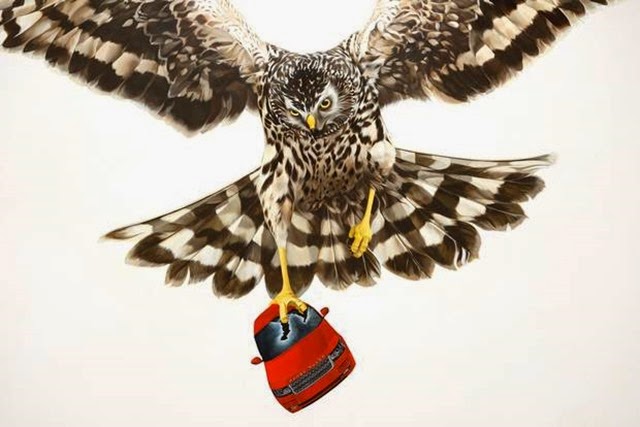
The story that had lodged in Deller's head and wouldn't go away was that 2007 incident of two of these rare birds being shot down over the Sandringham estate. The only people shooting that day, if you remember, were apparently Prince Harry and his friend William van Cutsem. Shooting the protected birds would carry a prison sentence but after police inquiries no action was taken. "That really annoyed me," Deller says with another smile, "so I thought I would do something with a giant hen harrier taking revenge on man, not Prince Harry necessarily, but man in general. It's called A Good Day for Cyclists because I am a cyclist in London, and as every cyclist knows, Range Rover drivers are the worst drivers by far, along with Porsche drivers. They are beyond the pale."
The artwork prompted us to find out more about this incident, hen harriers and why they would be shot even though it carries a prison sentence.
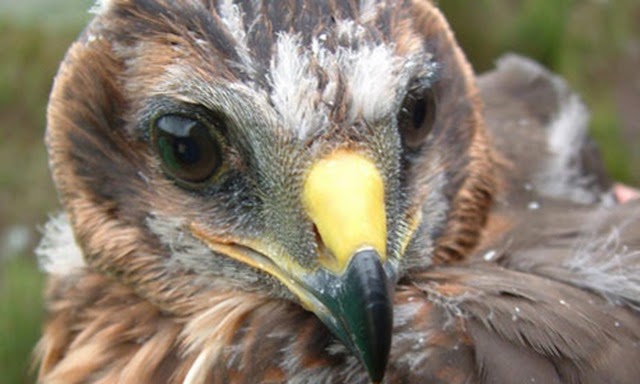
In this article we found out a little more. http://www.theguardian.com/environment/2010/oct/18/hen-harriers-grouse-moors
We learn, that it is thought that gamekeepers are deliberately killing these birds of prey in order to protect the grouse raised specifically for hunting. At £1,000 per day per gun, shooting is big business.
Hen harriers are now being considered an endangered species and are possibly facing extinction in Great Britain. You can read more about that here. http://www.theguardian.com/uk-news/2013/aug/09/hen-harrier-extinction-england
The controversy around grouse shooting and the killing of hen harriers continues. See below. http://raptorpolitics.org.uk/2014/08/01/the-people-have-spoken-ban-driven-grouse-shooting-petition-reaches-10000-ignitures/
Royals hunting animals for sport seems to be a hot topic at present.
The Maasai are under threat of eviction from their lands so that wealthy people can go there and shoot lions and other animals for pleasure. http://africageographic.com/blog/40-000-maasai-told-to-leave-homeland-as-hunters-move-in
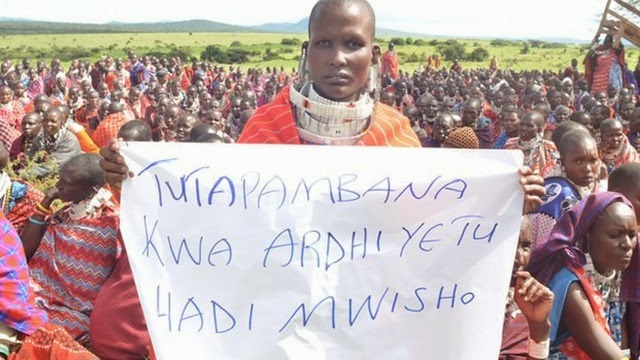
"We will fight for our land until the end."
The push is coming via Ortelo Business Corporation (OBC), a luxury safari company set up by a United Arab Emirates official close to the royal family. The OBC has operated in Loliondo for more than 20 years with clients reportedly including Prince Andrew. Since 1992, OBC has flown in wealthy clients to shoot lions and leopards, angering nomadic Maasai cattle herders who are blocked from pastures in the hunting grounds. Now OBC want to buy the land they have been using to hunt on.
The first Briton to enter the Serengeti, Stewart Edward White, recorded his explorations in the northern Serengeti in 1913. Stewart returned to the Serengeti in the 1920s and camped in the area around Seronera for three months. During this time, he and his companions shot 50 lions.
Because the hunting of lions made them scarce, the British colonial administration made a partial game reserve of 800 acres (3.2 km2) in the area in 1921 and a full one in 1929. These actions were the basis for Serengeti National Park, which was established in 1951.
In 1959 all people were evicted from the vast Serengeti by the British Government for the purpose of establishing the National Park. Among them the Maasai that were moved to Ngorongoro Conservation Area and also to Loliondo.
Contrary to promises the Tanzanian government has continued with a greedy eye on lands that it wants for the exclusive use of hunting and photographic tourism. Currently this greed is focused on a corridor of land in Loliondo Division of Ngorongoro District.
read more…..http://termitemoundview.blogspot.com.es/2013/03/the-tanzanian-government-insists-on.html
The people of Loliondo need help, as well as moral and material support, from anyone around the world with an idea about how to fight back or with a platform to speak from, and most needed of all is the support of those that have the fate of the landgrabbing government in their hand – the people of Tanzania.
Sign the petition here: http://action.sumofus.org/a/serengeti-land-grab/
So there we are, Jeremy and us have opened up a right can of worms regarding the killing of animals for sport. Remember, it began with big cars running over little animals in England. Is there a link between the two?
Telling people about our experiences cycling around Europe, we found ourselves often commenting on the fact that we would see living animals on cycle routes, voies vertes, green ways etc. and dead ones on the roads. Consequently we were given this book by a friend, whose central motif is that of road kill and one of the characters is referred to as ‘the fat’, a greedy, grabbing, wealthy business man. We thoroughly enjoyed the read.
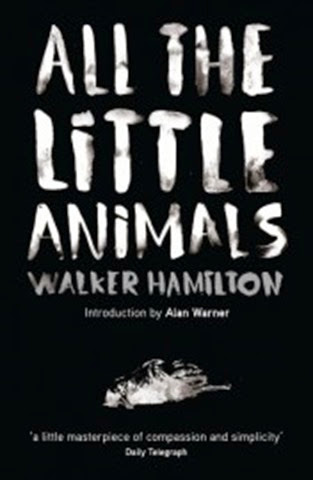
All the Little Animals - Walker Hamilton
A beguiling, perfectly dark, compelling, compassionate and original little gem of a modern fable set on the byways of rural Cornwall; a story about running away, the search for acceptance and burying road-kill.
It reads almost like a fairy story. But beneath its pastoral surface lies a brutal darkness that reaches its nadir in the book’s violent dénoument. With much of that violence coming from the encroachment of modernity on a more innocent world, in the form of cars and lorries.
And then Secret World…..
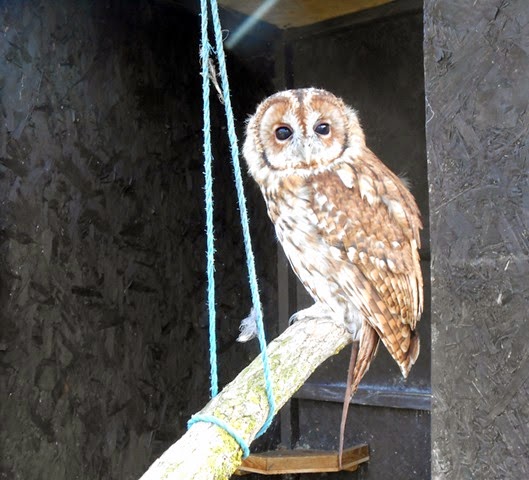
This little owl lives at Secret World, a 24 hours accident and emergency unit for wild animals, most of whom end up here because they have been hit by vehicles.
We spent a night there with baby weasels, fallow deer, badgers, hedgehogs, birds all being cared for. There was baby ducklings and otters coming in in washing up bowls, hedgehogs in incubators, orphaned ferrets wrapped up in tea towels…. At reception there was a price list of how much it cost to x-ray an otter hit by a car or put a deer on a drip or perform surgery on a swan that had swallowed a fishing hook…. it’s not cheap... http://www.secretworld.org/
Some people care for animals and others don’t.
So after all this we decided to share some of the horrors that we see and motorists don’t. We see dead animals on a daily basis, some days only a few and others just far too many.
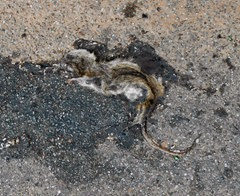
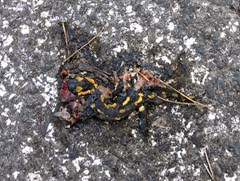
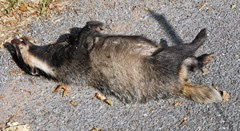
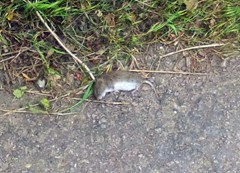

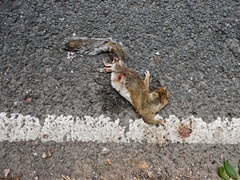
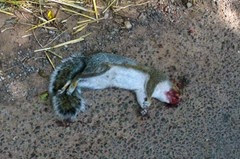
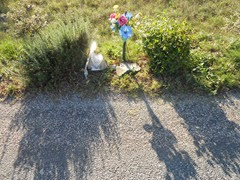
And of course it doesn’t stop with the animals.
Fortunately humans don’t get left out lying on the road, getting squashed again and again and again.
Here’s some figures to try and get your head around the numbers.
1 million mammals killed on UK roads every year Survey People's Trust for Endangered Species
The Global status report on road safety 2013 presents information on road safety from 182 countries, accounting for almost 99% of the world’s population. The report indicates that worldwide the total number of road traffic deaths remains unacceptably high at 1.24 million per year.
If it’s 1.24 million humans world wide and 1 million animals a year in the U.K. alone, how many animals is it world wide? 6 billion ???
75 people die on Europe's roads every day. That’s kind of like at least one aeroplane full of people crashing in Europe every week. Would that be acceptable?
World Day of Remembrance for human victims of road traffic was a week ago http://worlddayofremembrance.org/
We don’t think there is one for animals.
Some deaths are acceptable and some deaths are not?

No comments:
Post a Comment